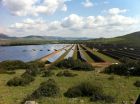(Press-News.org) Canada could save $7.3 billion annually with universal public coverage of medically necessary prescription drugs.
Canada is the only developed country with a universal health care system that does not include prescription drug coverage.
New research from the University of British Columbia and University of Toronto, published today in the Canadian Medical Association Journal , shows that universal public drug coverage, also known as universal pharmacare, is within reach for Canada even in times of government fiscal constraint.
"It's a win-win," said Steve Morgan, lead author of the study and professor of health policy at UBC's School of Population and Public Health. "A universal pharmacare system would improve the quality and accessibility of health care, while saving the Canadian economy billions of dollars every year."
The study modelled the cost of universal pharmacare based on data from $22-billion worth of prescription drug purchases in 2012-2013. The study's calculations included the cost of increased use of prescription drugs by Canadians who currently can't afford to fill those prescriptions.
Researchers found that increasing the use of generic drugs and bringing Canadian drug prices in line with other countries where universal drug plans achieve better prices through bulk purchasing and negotiation, would add up to significant savings.
"For too long, policy makers have assumed that universal Pharmacare is an expensive policy for governments - that assumption turns out to be wrong," said Dr. Danielle Martin, a co-other of the study and a professor at the University of Toronto. "With the money saved from using generic medicines, bulk purchasing, and better approaches to pricing, we can afford to cover medically necessary drugs for all Canadians without increasing taxes."
The study shows that the private sector, predominantly the employers and unions that sponsor work-related drug benefits today, would save between $6.5-billion and $9.6-billion annually with comparatively little increase costs to government. Under many plausible scenarios, total public spending on medicines would actually fall if Canada had a universal pharmacare system.
Government costs would be driven down by reducing the cost of medicines already paid for under public drug programs - which currently cost taxpayers almost $10-billion - and by reducing public spending on private insurance for public sector employees - which currently costs taxpayers over $2-billion.
Background
Universal pharmacare has been recommended for Canada since the 1960s, but was never implemented. One of the barriers to implementation has been the perception that it would necessitate substantial tax increases. The analysis published today shows that this need not be the case.
Currently in Canada, prescription drugs purchased outside of hospitals are financed through a mix of private and public drug plans that leave many Canadians with little or no drug coverage at all.
The study provided detailed estimates showing that universal pharmacare would reduce prescription drug spending in every province.
It also showed that the public cost of expanding public coverage for high-cost drugs - such as treatments for cancer and rheumatoid arthritis - would be modest and, under most plausible scenarios, would be offset by savings achieved in relatively common drug classes - like treatments for high cholesterol and high blood pressure.
Savings for Canada under the study's base scenario would put per capita pharmaceutical spending in Canada on par with the levels seen in comparable countries such as Switzerland, Austria, Spain, and Italy. Canadian spending would still be significantly higher than that in the United Kingdom, Sweden, Finland, the Netherlands, Norway, New Zealand and Denmark.
"Our study shows that universal pharmacare would save private citizens and corporations more than $8-billion at a cost to government of less than $1-billion. No government, no matter how fiscally conservative, should turn down that bargain," said Dr Morgan. "To put this another way, failure to implement a universal pharmacare system that is simply on par with comparable countries around the world will cost the Canadian economy nearly $100-billion over the course of a decade."
INFORMATION:
ANN ARBOR--Whether you're baking bread or building an organism, the key to success is consistently adding ingredients in the correct order and in the right amounts, according to a new genetic study by University of Michigan researchers.
Using the baker's yeast Saccharomyces cerevisiae, Patricia Wittkopp and her colleagues developed a novel way to disentangle the effects of random genetic mutations and natural selection on the evolution of gene expression. Their findings are scheduled for online publication in the journal Nature on March 16.
"These results tell us that ...
A new study from the University of Birmingham and the MRC Cognition and Brain Sciences unit in Cambridge has shown how intentional recall is beyond a simple reawakening of a memory; and actually leads us to forget other competing experiences that interfere with retrieval. Quite simply, the very act of remembering may be one of the major reasons why we forget.
The research, published today in Nature Neuroscience, is the first to isolate the adaptive forgetting mechanism in the human brain. The brain imaging study shows that the mechanism itself is implemented by the suppression ...
The largest genetic study of tuberculosis (TB) susceptibility to date has led to a potentially important new insight into how the pathogen manages to evade the immune system. Published today in the journal Nature Genetics, the study advances understanding of the biological mechanisms involved in TB, which may open up new avenues to design efficient vaccines for its prevention.
TB, caused by infection with the pathogen Mycobacterium tuberculosis, is a major global public health problem. According to the World Health Organization, in 2013 nine million people fell ill with ...
A Venezuelan evolutionary biologist and a US zoologist state that they have refuted, through mitochondrial DNA sequencing, a recent claim, also based on such sequencing, that unknown type of bear must exist. in the Himalayas and that it may be, at least in part, the source of yeti legends. Their study was published in the open access journal ZooKeys.
Last year, B. Sykes and co-authors, in the course of mitochondrial DNA sequencing identification of hair samples that had been attributed to "anomalous primates" (yetis, bigfoots, and others), claimed to have found that ...
Berkeley -- Hard-wiring beetles for radio-controlled flight turns out to be a fitting way to learn more about their biology. Cyborg insect research led by engineers at the University of California, Berkeley, and Singapore's Nanyang Technological University (NTU) is enabling new revelations about a muscle used by beetles for finely graded turns.
By strapping tiny computers and wireless radios onto the backs of giant flower beetles and recording neuromuscular data as the bugs flew untethered, scientists determined that a muscle known for controlling the folding of wings ...
In the face of global climate change, increasing the use of renewable energy resources is one of the most urgent challenges facing the world. Further development of one resource, solar energy, is complicated by the need to find space for solar power-generating equipment without significantly altering the surrounding environment.
New work from Carnegie's Rebecca R. Hernandez (now at University of California Berkley), Madison K. Hoffacker, and Chris Field found that the amount of energy that could be generated from solar equipment constructed on and around existing infrastructure ...
Northwestern University scientists have developed a robust new material, inspired by biological catalysts, that is extraordinarily effective at destroying toxic nerve agents that are a threat around the globe. First used 100 years ago during World War I, deadly chemical weapons continue to be a challenge to combat.
The material, a zirconium-based metal-organic framework (MOF), degrades in minutes one of the most toxic chemical agents known to mankind: Soman (GD), a more toxic relative of sarin. Computer simulations show the MOF should be effective against other easy-to-make ...
"Warmer air transports more moisture and hence produces more precipitation - in cold Antarctica this takes the form of snowfall," lead author Katja Frieler from the Potsdam Institute for Climate Impact Research (PIK) explains. "We have now pulled a number of various lines of evidence together and find a very consistent result: Temperature increase means more snowfall on Antarctica," says Frieler. "For every degree of regional warming, snowfall increases by about 5 percent." Published in the journal Nature Climate Change, the scientists' work builds on high-quality ice-core ...
Researchers have discovered a valley underneath East Antarctica's most rapidly-changing glacier that delivers warm water to the base of the ice, causing significant melting.
The intrusion of warm ocean water is accelerating melting and thinning of Totten Glacier, which at 65 kilometres long and 30 kilometres wide contains enough ice to raise global sea levels by 3.5 metres. The glacier is one of the major outlets for the East Antarctic Ice Sheet, which is the largest mass of ice on Earth and covers 98 percent of the continent.
Climate change is raising the temperature ...
CORVALLIS, Ore. - A new study confirms that snowfall in Antarctica will increase significantly as the planet warms, offsetting future sea level rise from other sources - but the effect will not be nearly as strong as many scientists previously anticipated because of other, physical processes.
That means that many computer models may be underestimating the amount and rate of sea level rise if they had projected more significant impact from Antarctic snow.
Results of the study, which was funded by the National Science Foundation, were reported this week in the journal ...

